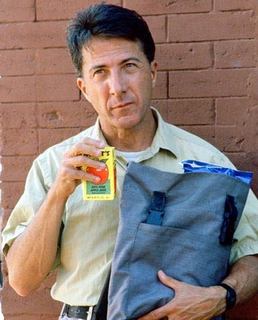15 KiB
Seven Languages in Seven Weeks
Introduction
Introduction
Prolog BMCOL
- Created
- 1972
- Author
- Alain Colmerauer and Phillipe Roussel
A declarative logic programming language.
Rain Man BMCOL

Getting Prolog
GNU Prolog
SWI Prolog
Day 1
Day 1: An Excellent Driver
- Atoms & Variables
- Facts & Rules
- Unification
Atoms & Variables
Atoms
- Begin with a lowercase letter.
Variables
- Begin with an uppercase letter.
Basic Facts & Queries
Rules & Facts BMCOL
Facts
likes(wallace, cheese).
likes(grommit, cheese).
likes(wendolene, sheep).Rules
friend(X, Y) :- \+(X = Y),
likes(X, Z),
likes(Y, Z).Queries B_example BMCOL
likes(wallace, sheep).
%% false likes(grommit, cheese).
%% true friend(grommit, wallace).
%% true friend(wallace, grommit).
%% true friend(wendolene, grommit).
%% falseFilling in the Blanks
Food Facts BMCOL
Facts
food_type(velveeta, cheese).
food_type(ritz, cracker).
food_type(spam, meat).
food_type(sausage, meat).
food_type(jolt, soda).
food_type(twinkie, dessert).
flavor(sweet, desert).
flavor(savory, meat).
flavor(savory, cheese).
flavor(sweet, soda).Rules
food_flavor(X, Y) :- food_type(X, Z),
flavor(Y, Z).Queries B_example BMCOL
food_type(What, meat).
%% What = spam ;
%% What = sausage. food_flavor(sausage, sweet).
%% false. flavor(sweet, What).
%% What = dessert ;
%% What = soda. food_flavor(What, savory).
%% What = velveeta ;
%% What = spam ;
%% What = sausage.Map Coloring: Problem
Map BMCOL

Problem BMCOL
- We want to color a map of the southeastern United States.
- We do not want two states of the same color to touch.
- We will use three colors: red, blue, and green.
Map Coloring: Solution
Map Facts BMCOL
Facts
different(red, green). different(red, blue).
different(green, red). different(green, blue).
different(blue, red). different(blue, green).
coloring(Alabama, Mississippi,
Georgia, Tennessee, Florida) :-
different(Mississippi, Tennessee),
different(Mississippi, Alabama),
different(Alabama, Tennessee),
different(Alabama, Mississippi),
different(Alabama, Georgia),
different(Alabama, Florida),
different(Georgia, Florida),
different(Georgia, Tennessee).Query B_example BMCOL
coloring(Alabama, Mississippi,
Georgia, Tennessee, Florida).
%% Alabama = blue,
%% Florida = green,
%% Georgia = red ,
%% Mississippi = red,
%% Tennessee = green ;Unification, Part 1
Facts & Rules BMCOL
Unification
Unification across two structures tries to make both structures identical.
Facts
cat(lion).
cat(tiger).Rules
dorothy(X, Y, Z) :- X = lion,
Y = tiger,
Z = bear.
twin_cats(X, Y) :- cat(X), cat(Y).Unification B_example BMCOL
dorothy(lion, tiger, bear).
%% true.
dorothy(One, Two, Three).
%% One = lion,
%% Two = tiger,
%% Three = bear.
twin_cats(One, Two).
%% One = lion,
%% Two = lion ;
%% One = lion,
%% Two = tiger ;
%% One = tiger,
%% Two = lion ;
%% One = tiger,
%% Two = tiger.Interview
An interview with Brian Tarbox, Dolphin Researcher
Exercises
EXERCISES
Day 2
Day 2: Fifteen Minutes to Wapner
- Recursion
- Lists and Tuples
- Unification
- Lists and Math
- Using rules in Both Directions
Recursion
The following rules define the paternal family tree of the Waltons. They express a father relationship and from that infers the ancestor relationship. Since an ancestor can mean a father, grandfather, or great grandfather, we will need to nest the rules or iterate.
father(zeb, john_boy_sr).
father(john_boy_sr, john_boy_jr).
ancestor(X, Y) :-
father(X, Y).
ancestor(X, Y) :-
father(X, Z), ancestor(Z, Y).
In the above example, ancestor(Z, Y) is a recursive subgoal.
Lists and Tuples
- Lists are containers of variable length.
- Tuples are containers with a fixed length.
Unification, Part 2: Tuples
Tuples unify if they have the same number of elements, and each element unifies.
(1, 2, 3) = (1, 2, 3). %% true
(1, 2, 3) = (1, 2, 3, 4). %% false
(1, 2, 3) = (3, 2, 1). %% falseUnification, Part 2: Lists
Lists behave similarly, but can be deconstructed with the pattern
[Head|Tail].
[1, 2, 3] = [1, 2, 3]. %% true
[2, 2, 3] = [X, X, Z]. %% X = 2, Z = 3
[a, b, c] = [Head|Tail]. %% Head = a, Tail = [b, c]
[] = [Head|Tail]. %% false
[a] = [Head|Tail]. %% Head = a, Tail = []
[a, b, c] = [a|[Head|Tail]]. %% Head = b, Tail = [c]
[a, b, c, d, e] = [_, _|[Head|_]]. %% Head = cLists and Math
Count
count(0, []).
count(Count, [Head|Tail]) :- count(TailCount, Tail), Count is TailCount + 1.Sum
sum(0, []).
sum(Total, [Head|Tail]) :- sum(Sum, Tail), Total is Head + Sum.Average
average(Average, List) :- sum(Sum, List), count(Count, List), Average is Sum/Count.Using Rules in Both Directions
The rule append(List1, List2, List3) is true if List3 is List1 +
List2.
Left BMCOL
… as a lie detector
append([oil], [water],
[oil, water]). %% true
append([oil], [water],
[oil, slick]). %% false… as a list builder
append([tiny], [bubbles],
What).
%% What = [tiny, bubbles]Right BMCOL
… for list subtraction
append([dessert_topping], Who,
[dessert_topping, floor_wax]).
%% Who = [floor_wax]… for computing possible splits
append(One, Two,
[apples, oranges, bananas]).
%% One = [], Two = [apples, oranges, bananas]
%% One = [apples], Two = [oranges, bananas]
%% One = [apples, oranges], Two = [bananas]
%% One = [apples, oranges, bananas], Two = []Implementing append/3
Steps:
- Write a rule called
concatenate(List1, List2, List3)that can concatenate an empty list toList1. - Add a rule that concatenates one item from
List1ontoList2. - Add a rule that concatenates two and three items from
List1ontoList2. - See what we can generalize.
concatenate/3: Step 1
concatentate/3 is true if the first parameter is an empty list and
the next two parameters are the same.
concatenate([], List, List).Test B_example
concatenate([], [harry], What).
%% What = [harry]concatenate/3: Step 2
Add a rule that concatenates the first element of List1 tot he front
of List2:
concatenate([Head|[]], List, [Head|List]).Test B_example
concatenate([malfoy], [potter], What).
%% What = [malfoy, potter]concatenate/3: Step 3
Define another couple of rules to concatenate lists of lengths 2 and 3:
concatenate([Head1|[Head2|[]]], List, [Head1, Head2|List]).
concatenate([Head1|[Head2|[Head3|[]]]], List, [Head1, Head2, Head3|List])Test B_example
concatenate([malfoy, granger], [potter], What).
%% What = [malfoy, granger, potter]concatenate/3: Step 4
Generalize for lists of arbitrary length using nested rules:
concatenate([], List, List).
concatenate([Head|Tail1], List, [Head|Tail2]) :-
concatenate(Tail1, List, Tail2).Exercises
EXERCISES
Day 3
Day 3: Blowing Up Vegas
- Sudoku
- Eight Queens
Solving Sudoku: The Problem
- For a solved puzzle, the numbers in the puzzle and solution should be the same.
- A Sudoku board is a grid of sixteen cells, with values from 1-4.
- The board has four rows, four columns, and four squares.
- A puzzle is valid if the elements in each row, column, and square has no repeated elements.
Example B_example
sudoku([_, _, 2, 3,
_, _, _, _,
_, _, _, _,
3, 4, _, _],
Solution).Solving Sudoku: The Solution
Left BMCOL
valid([]).
valid([Head|Tail]) :-
fd_all_different(Head),
valid(Tail).
sudoku(Puzzle, Solution) :-
Solution = Puzzle,
Puzzle = [S11, S12, S13, S14,
S21, S22, S23, S24,
S31, S32, S33, S34,
S41, S42, S43, S44],
fd_domain(Solution, 1, 4),
Row1 = [S11, S12, S13, S14],
Row2 = [S21, S22, S23, S24],
Row3 = [S31, S32, S33, S34],
Row4 = [S41, S42, S43, S44],Right BMCOL
Col1 = [S11, S21, S31, S41],
Col2 = [S12, S22, S32, S42],
Col3 = [S13, S23, S33, S43],
Col4 = [S14, S24, S34, S44],
Square1 = [S11, S12, S21, S22],
Square2 = [S13, S14, S23, S24],
Square3 = [S31, S32, S41, S42],
Square4 = [S33, S34, S43, S44],
valid([Row1, Row2, Row3, Row4,
Col1, Col2, Col3, Col4,
Square1, Square2, Square3, Square4]).Eight Queens: The Problem
- A board has eight queens.
- Each queen has a row from 1-8 and a column from 1-8.
- No two queens can share the same row.
- No two queens can share the same column.
- No two queens can share the same diagonal (southwest to northeast).
- No two queens can share the same diagonal (northwest to southeast).
Eight Queens: The Solution
Left BMCOL
valid_queen((Row, Col)) :-
member(Col, [1,2,3,4,5,6,7,8]).
valid_board([]).
valid_board([Head|Tail]) :-
valid_queen(Head), valid_board(Tail).
cols([], []).
cols([(_, Col)|QueensTail], [Col|ColsTail]) :-
cols(QueensTail, ColsTail).
diags1([], []).
diags1([(Row, Col)|QueensTail],
[Diagonal|DiagonalsTail]) :-
Diagonal is Col - Row,
diags1(QueensTail, DiagonalsTail).Right BMCOL
diags2([], []).
diags2([(Row, Col)|QueensTail],
[Diagonal|DiagonalsTail]) :-
Diagonal is Col + Row,
diags2(QueensTail, DiagonalsTail).
eight_queens(Board) :-
Board = [(1, _), (2, _), (3, _), (4, _),
(5, _), (6, _), (7, _), (8, _)],
valid_board(Board),
cols(Board, Cols),
diags1(Board, Diags1),
diags2(Board, Diags2),
fd_all_different(Cols),
fd_all_different(Diags1),
fd_all_different(Diags2).Exercises
EXERCISES
Wrapping Up
Wrapping Up Prolog: Strengths
- Natural-Language Processing
- Games
- Semantic Web
- Artificial Intelligence
- Scheduling
Wrapping Up Prolog: Weaknesses
- Utility
- Very Large Data Sets
- Mixing the Imperative and Declarative Models
Final Thoughts
Prolog was a particularly poignant example of my evolving understanding. If you find a problem that's especially well suited for Prolog, take advantage. In such a setting, you can best use this rules-based language in combination with other general-purpose languages, just as you would use SQL within Ruby or Java.